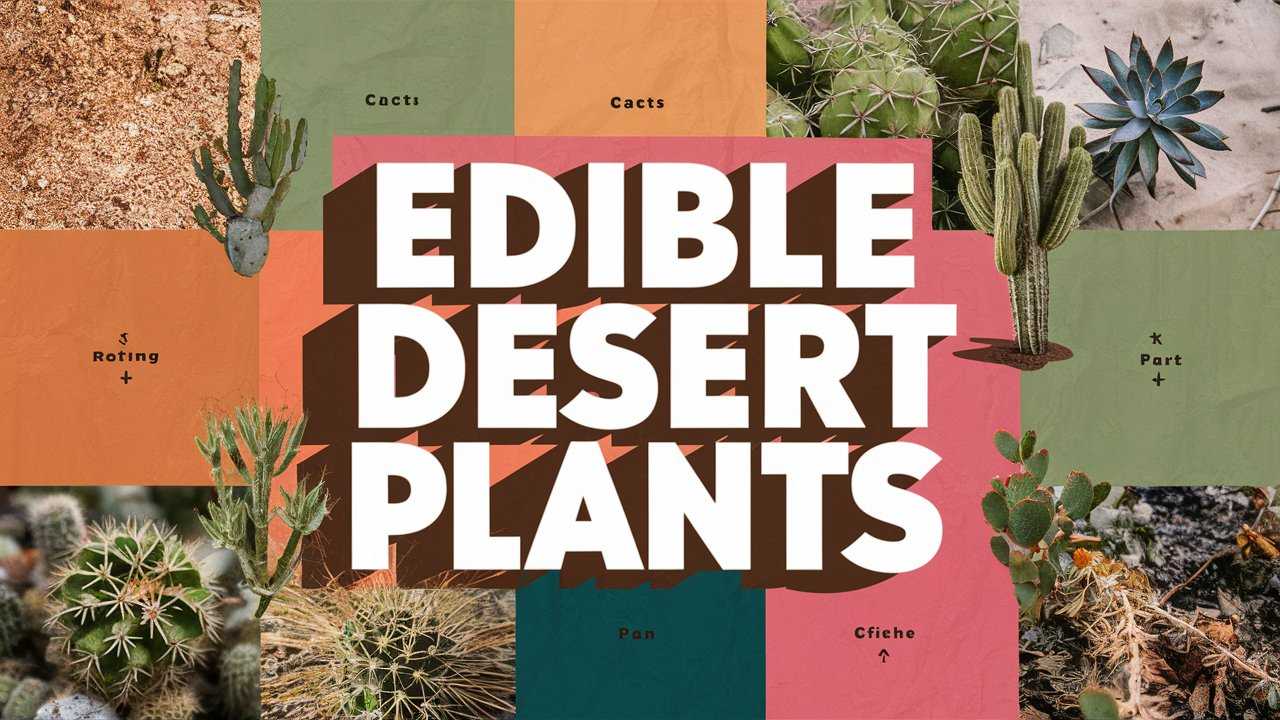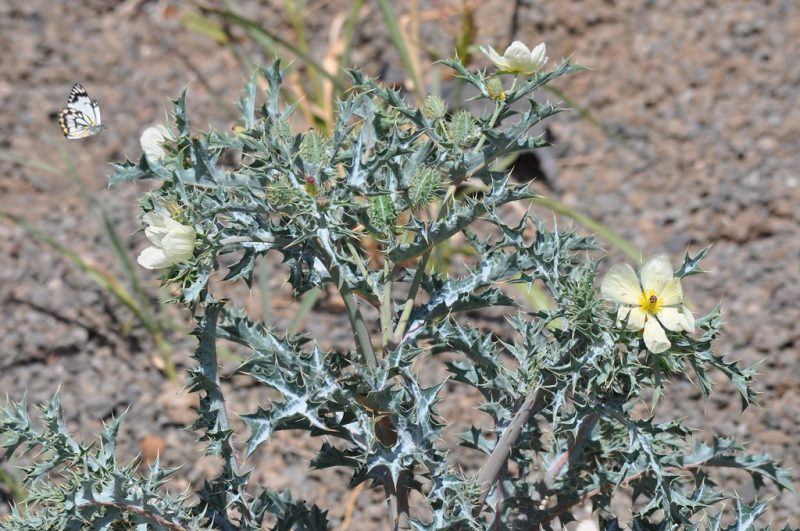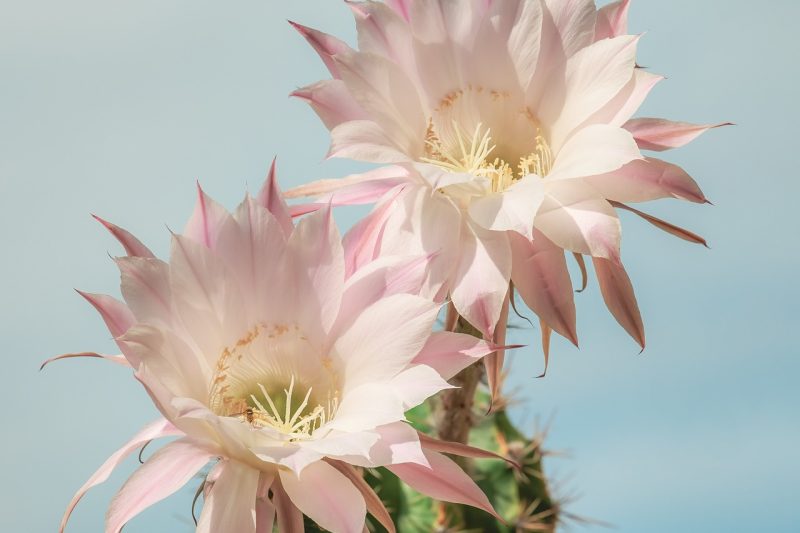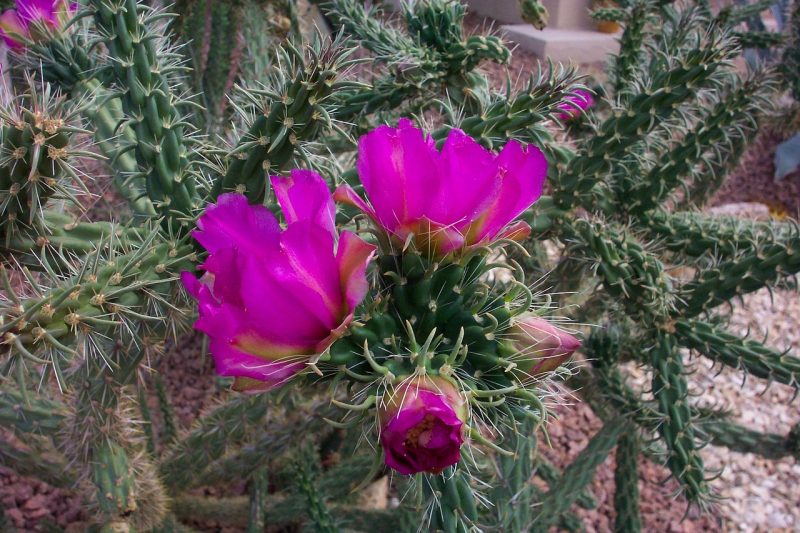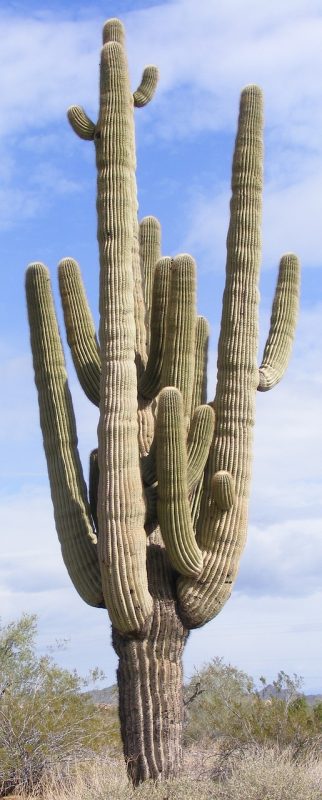Incorporating these edible desert plants into diets can enhance food diversity, support sustainable practices, and promote health. As more people seek out natural and locally sourced food options, the appreciation for these hardy, nutrient-rich plants continues to grow.
Whether you are foraging, gardening, or exploring desert cuisine, embracing edible desert plants opens a world of flavors and culinary possibilities while highlighting the importance of biodiversity in our ecosystems.
Prickly Pear Cactus (Opuntia spp.)
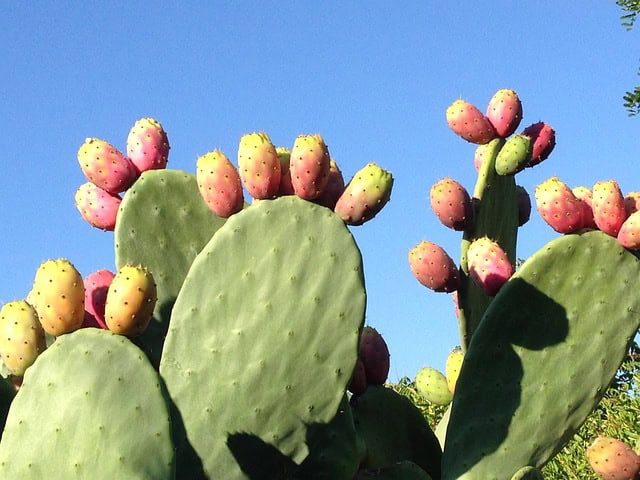
The prickly pear cactus is perhaps one of the most recognizable edible plants in desert landscapes, adorned with vibrant pads and striking fruits known as “tunas.” The pads, also called nopales, are not only edible but are packed with nutritional benefits, offering a rich source of vitamins C and K, fiber, and antioxidants. In culinary practices, nopales are often grilled, diced into salads, or incorporated into salsas, providing a distinct tangy flavor and a unique texture reminiscent of green beans.
Beyond their culinary appeal, prickly pear fruits are a source of vibrant color and flavor. Characterized by their bright pink or purplish hue, these succulent fruits can be extracted into jellies, used in beverages, or enjoyed fresh. The fruit’s slightly sweet, complex flavor is often likened to a mix of watermelon and bubblegum. Notably, prickly pears are low in calories and high in hydration, making them an excellent food source in arid climates.
Additionally, the medicinal properties of prickly pear warrant attention. Traditional herbal medicine has utilized its various parts for managing diabetes, lowering cholesterol levels, and even treating gastrointestinal issues. Recent studies indicate that compounds found in prickly pear may help regulate blood sugar levels and reduce inflammation, demonstrating its multifaceted benefits.
Mesquite (Prosopis spp.)
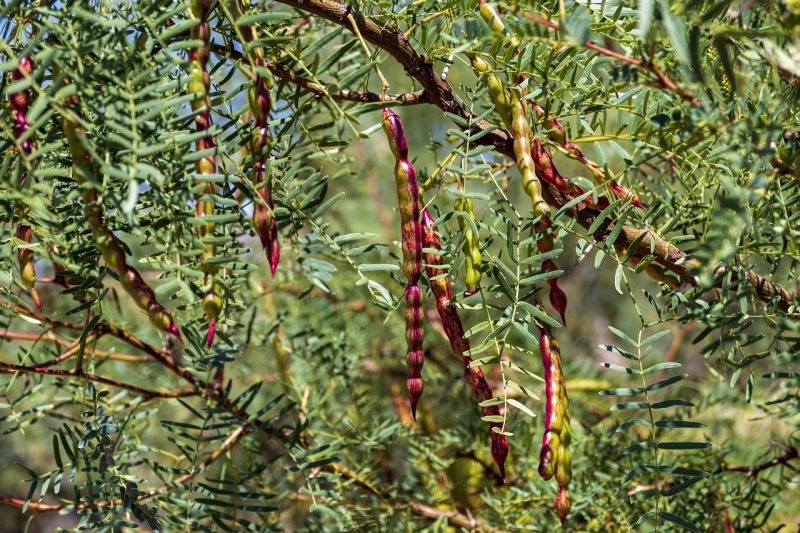
Mesquite trees are iconic in the arid terrains of the American Southwest, thriving in extremely dry conditions. Their pods, rich in nutrients, are a hidden gem in the realm of edible desert plants. The sweet, fibrous pods can be ground into flour, which is becoming increasingly popular among health-conscious consumers and chefs alike. Mesquite flour has a distinct, slightly sweet, and nutty flavor, making it an interesting substitute for wheat flour in various dishes, including baked goods, pancakes, and even smoothies.
Rich in protein, dietary fiber, and essential minerals such as calcium, magnesium, and potassium, mesquite flour offers a nutritious boost to meals. It also has a low glycemic index, making it a favorable option for those managing blood sugar levels. Beyond the culinary applications, mesquite pods have historically played a vital role in the diets of Indigenous peoples, serving as an important carbohydrate source that was often ground into meal for porridge or flatbreads.
Moreover, the mesquite tree is not just a food provider; it is also an architect of sustainable desert ecosystems. Its roots stabilize the soil and enhance fertility, thus supporting the growth of other vegetation. For conscientious gardeners and food enthusiasts, growing mesquite can be a step toward promoting biodiversity and sustainability in arid environments.
Desert Chia (Salvia hispanica)
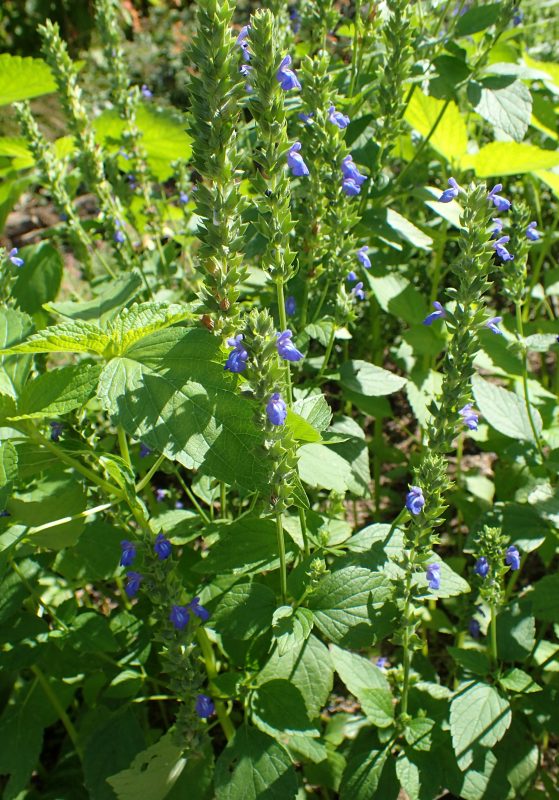
Chia seeds, once a staple of ancient Mesoamerican diets, are now recognized worldwide for their impressive health benefits, but many may not realize that the wild varieties of chia, including Desert Chia, thrive in arid landscapes. This plant, often overlooked, is remarkably well-adapted to the desert’s fluctuating temperatures and scarcity of water. As a drought-resistant species, Desert Chia completes its life cycle rapidly, producing seeds that are not only highly nutritious but also resilient.
The seeds of Desert Chia are packed with omega-3 fatty acids, protein, fiber, and a myriad of vitamins and minerals, marking them as a superfood in the contemporary health movement. When soaked, these seeds expand significantly, creating a gel-like texture, which can be used in puddings, smoothies, or as an egg substitute in vegan baking. Their ability to absorb liquid makes them an excellent addition to recipes requiring a binding agent or thickening agent.
Beyond their culinary applications, the flowering tops of Desert Chia serve an ecological purpose, attracting pollinators and contributing to the biodiversity of the desert environment. Their role in traditional medicine includes uses for treating digestive ailments and boosting metabolism. As the modern world increasingly shifts towards plant-based diets, integrating Desert Chia and its other edible counterparts into daily nutrition can support health and wellness while respecting the natural biodiversity of desert ecosystems.
Agave (Agave spp.)
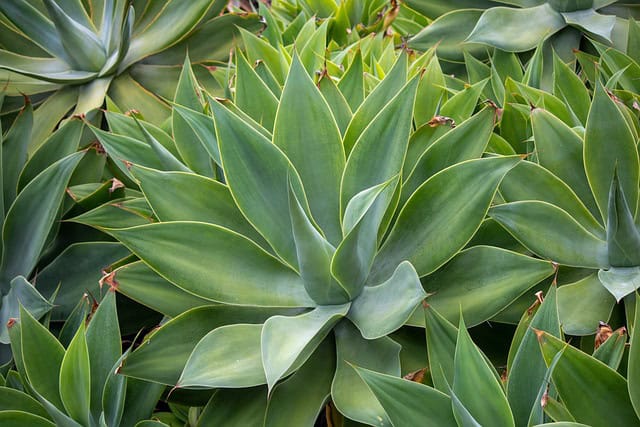
Agave plants are striking members of the succulent family, recognized not only for their architectural beauty but also for their myriad culinary uses. Found predominantly in the deserts of Mexico and the Southwestern United States, agave serves as a versatile source of food and beverages. The most famous among its products is tequila, distilled from the blue agave, but this remarkable plant offers far more than just spirits.
The piña, or heart of the agave plant, can be roasted and consumed as a sweet, fibrous treat. Its flavor profile is often described as caramel-like, making it a great addition to both savory and sweet dishes. In traditional cuisine, it is common to find roasted agave in tacos, salads, or even as a standalone side dish. The sap of the agave can also be processed into a syrup, known as agave nectar, which serves as a natural sweetener and is often used as an alternative to sugar in various culinary applications.
Moreover, agave has health benefits worth noting. It is a source of inulin, a prebiotic fiber that promotes digestive health by fostering beneficial gut bacteria and aiding in blood sugar regulation. Indigenous cultures have long revered agave not just for its dietary value but also for its medicinal applications, utilizing it in various remedies for wounds and digestive ailments. As a drought-resistant plant, agave plays a crucial role in sustainable agriculture, requiring minimal water and thriving in hostile environments, thereby exemplifying a harmonious relationship with nature.
Prickly Poppy (Argemone spp.)
The prickly poppy, while often overlooked, is an intriguing edible desert plant worth exploring. With its striking yellow or white flowers and spiny, lobed leaves, this wildflower can be found in dry, disturbed areas across the U.S. Southwest and northern Mexico. While it is commonly treated as a weed due to its prickly nature, the prickly poppy offers unique edible properties that have been utilized by Indigenous populations for centuries.
The unripe seed pods and young leaves are edible and can be prepared for consumption when cooked properly. The leaves’ slightly bitter flavor can add a distinctive taste to dishes, while the seeds can be harvested and roasted as a crunchy addition to salads or cereals. However, caution is advised as some parts of the plant contain alkaloids that can be toxic if consumed in large quantities or if the plant is improperly prepared. Awareness of safe harvesting and cooking practices is essential when working with prickly poppy.
Beyond its edibility, the prickly poppy has drawn the attention of herbalists for its potential medicinal properties. Some traditional remedies involve preparing infusions from the leaves or flowers to alleviate pain or aid digestion, though scientific studies are limited. Ecologically, the prickly poppy is vital for desert ecosystems, providing food for various pollinators and other wildlife. Its resilience in harsh environments exemplifies nature’s ingenuity, offering lessons in survival that could inspire sustainable practices among modern gardeners.
Sotol (Dasylirion spp.)
Sotol, a lesser-known but equally fascinating desert plant, hails from the Chihuahuan Desert and is closely related to both the agave and the yucca. Like its relatives, sotol has deep cultural significance and a variety of practical uses. The leaves of the sotol plant are long, rigid, and spiky, making them suitable for basket weaving and traditional crafts used by Indigenous peoples throughout the region.
The heart of the sotol plant can be harvested and processed to produce a distilled alcoholic beverage, known as sotol, which has been brewed for centuries and is gaining traction in modern craft distilleries. Distillers value sotol for its unique taste profile, which varies based on the plant’s age, the terroir, and the specific distillation process. The flavor of sotol can range from earthy to herbal, with complex notes that make it a sophisticated alternative to tequila or mezcal.
Nutritively, the sotol plant is noted for its high fiber content, making it a valuable food source. While primarily recognized for its alcoholic output and fiber, the young flower stalks can also be roasted and eaten, providing a nutrient-rich food source that is sweet and tender. Traditionally, sotol has been utilized as a foraged food item, demonstrating the resourcefulness of desert inhabitants.
Sotol’s role transcends just food and drink; it plays a significant part in maintaining desert ecosystems. Its deep roots stabilize the soil and help prevent erosion, while its flowers attract a variety of pollinators. As climate change poses challenges to traditional farming practices, exploring sustainable crops such as sotol may present exciting opportunities for integrating resilient species into agricultural systems in arid landscapes.
Yucca (Yucca spp.)
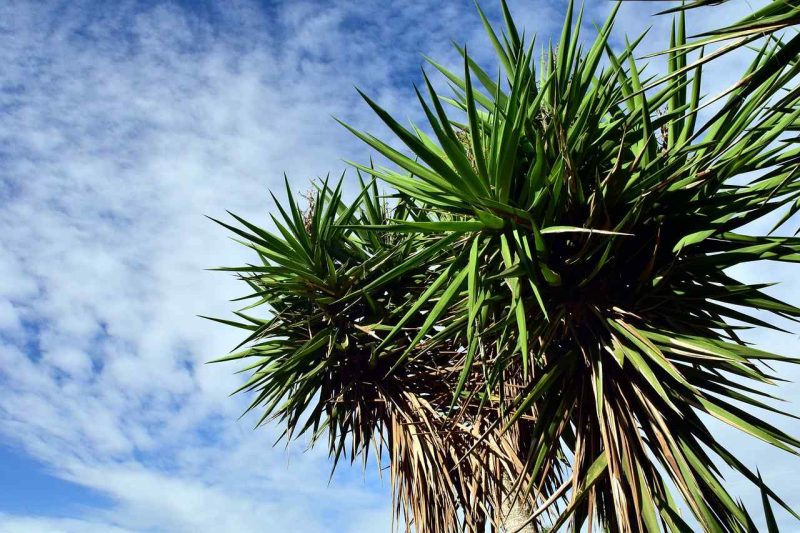
Yucca plants are an indispensable resource in desert ecosystems, with numerous species thriving in arid environments throughout the Southwestern United States and Mexico. Beyond their striking spiky appearance and tall flower stalks adorned with creamy white blooms, yucca plants have served as essential sources of food, fiber, and medicine for countless generations.
The young flower buds, shoots, and roots of yucca are edible, offering a variety of culinary applications. The tender flower buds can be harvested and enjoyed raw in salads, while the roots can be cooked or ground into flour, providing a gluten-free alternative to traditional grain flours. With a mild flavor reminiscent of potatoes, yucca root can be roasted, boiled, or mashed, making it a versatile ingredient for various dishes.
In addition to their edibility, yucca plants have showcased profound medicinal benefits. Traditionally, indigenous peoples have utilized yucca extracts to treat ailments such as arthritis and inflammation due to their high saponin content, which is known to have anti-inflammatory properties. The sap from the leaves has also found use in natural soaps and shampoos due to its foaming quality, exemplifying the plant’s multifaceted benefits.
Moreover, yucca’s ecological contributions are equally impressive. These plants are instrumental in sustaining local wildlife, as their flowers attract pollinators like bees and hummingbirds, while the fleshy leaves provide shelter and food for various desert animals. The resilience of yucca to desert conditions underscores the importance of these adaptable plants, serving as both a food source and an architectural feature in arid landscapes.
Ocotillo (Fouquieria spp.)
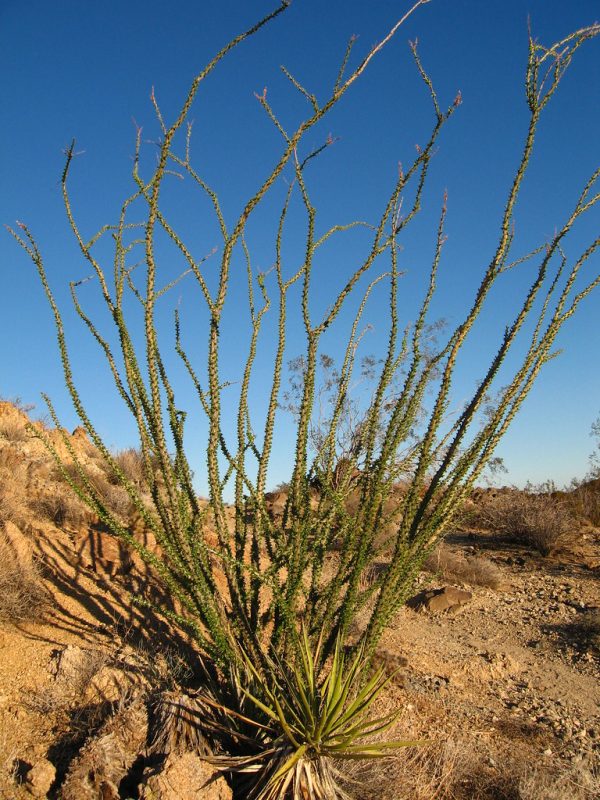
Ocotillo is a visually stunning plant that embodies the spirit of the desert with its tall, slender stems reaching high into the sky. Although classified botanically as a shrub, its vertical growth and branching patterns create an impression of a tree-like structure. During periods of drought, ocotillo appears barren, but after rainfall, it bursts into life, producing vibrant red tubular flowers that are irresistible to hummingbirds and other pollinators.
While ocotillo is primarily known for its ornamental beauty, its flowers and young shoots are edible and can be enjoyed in various culinary creations. The blooms can be harvested and added to salads, lending a splash of color and a hint of sweetness, while the tender green shoots can be steamed or grilled, providing a fresh and nutritious addition to meals. The young stems are high in fiber and, when dried, can be used to make a soothing herbal tea known for its hydrating properties.
In traditional medicine, ocotillo has been appreciated for its potential health benefits, often being used to alleviate symptoms such as cough and fever. Some prefer using the plant’s inner bark for medicinal infusions, embracing its natural healing qualities. Ecologically, ocotillo plays a vital role in desert habitats, providing essential nectar for pollinators and offering cover for wildlife. Its deep root system also helps in stabilizing sandy soils, minimizing erosion in delicate desert ecosystems.
Joshua Tree (Yucca brevifolia)
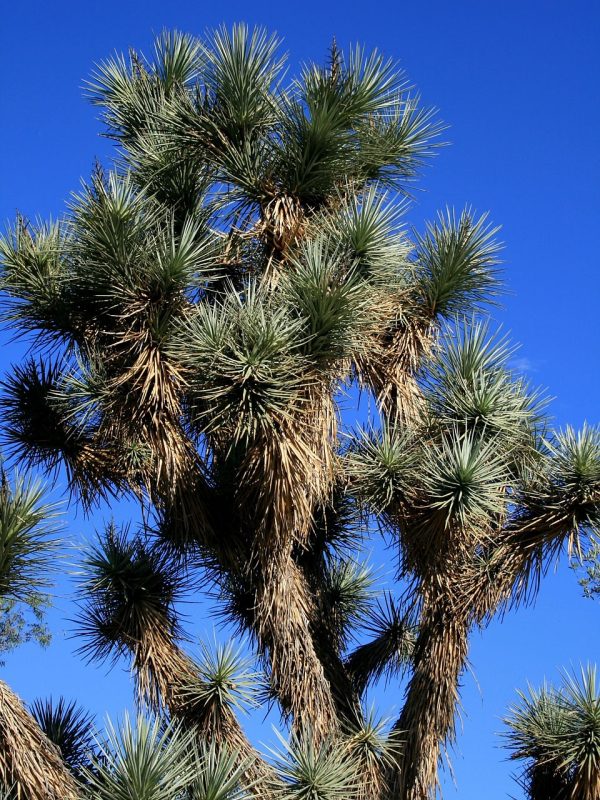
Joshua Trees are iconic figures in the Mojave Desert, easily recognizable by their unique, twisted branches and spiky leaves. Although they belong to the yucca family, Joshua Trees offer their own distinct characteristics and cultural significance. These resilient trees thrive in harsh, dry conditions and are adapted to withstand extreme temperatures, making them ideal representatives of desert flora.
The young flower clusters and inflorescences of the Joshua Tree are edible, although they are less commonly harvested compared to other desert plants. The flowers can be enjoyed raw or cooked, offering a delicate flavor that can complement various dishes. Additionally, the seeds can be collected, roasted, and consumed, providing a nutty taste and an excellent source of nutrition. Historically, indigenous peoples have used the seeds and flowers in their diets, celebrating the plant’s resilience and contributions to their survival.
Joshua Trees hold considerable ecological importance, providing habitat and sustenance for numerous species, including birds, insects, and small mammals. The trees are vital for maintaining biodiversity in their ecosystems by acting as a shelter and nesting site for bird species, while their flowers offer a food source for pollinators. The symbiotic relationships formed within Joshua Tree habitats demonstrate the interconnectedness of desert life and the significance of conserving these striking trees.
As symbols of the American Southwest, Joshua Trees have become a focal point for environmental awareness and conservation efforts. Their role in maintaining desert ecosystems and their cultural heritage as icons of beauty underscores the need to protect these unique plants from the threats posed by climate change and urban development.
Barrel Cactus (Echinocactus spp.)
The barrel cactus, often characterized by its barrel-shaped body and ribbed structure, is a striking feature of many desert landscapes. Commonly found throughout the arid regions of North America, especially in the Sonoran and Mojave deserts, these cacti not only add to the aesthetic beauty of their surroundings but also provide a vital source of sustenance and hydration in harsh conditions.
The most well-known edible components of the barrel cactus are its fruits, often referred to as “cactus apples” or “cactus berries.” These fleshy, red or yellow fruits emerge from the top of the cactus and have a sweet, juicy pulp that can be enjoyed raw or used in jams, jellies, and beverages. Harvesting the fruit often involves a careful approach to avoid the spines, which can be quite sharp. When prepared properly, the taste of cactus fruit can be described as a combination of kiwi and watermelon, making it a delightful addition to salads or smoothies.
Beyond the fruit, the pulp of the barrel cactus can also be consumed, particularly during periods of drought when other food sources may be scarce. The inner flesh of the cactus contains moisture and carbohydrates, providing essential hydration and energy. Traditionally, Indigenous peoples have utilized the barrel cactus for sustenance, incorporating it into their diets alongside other desert plants. Furthermore, the plant’s structure and resilience offer excellent examples of nature’s adaptation to water scarcity, and its ability to store significant amounts of water within its tissues makes it a symbol of survival in the desert.
Dragon Fruit
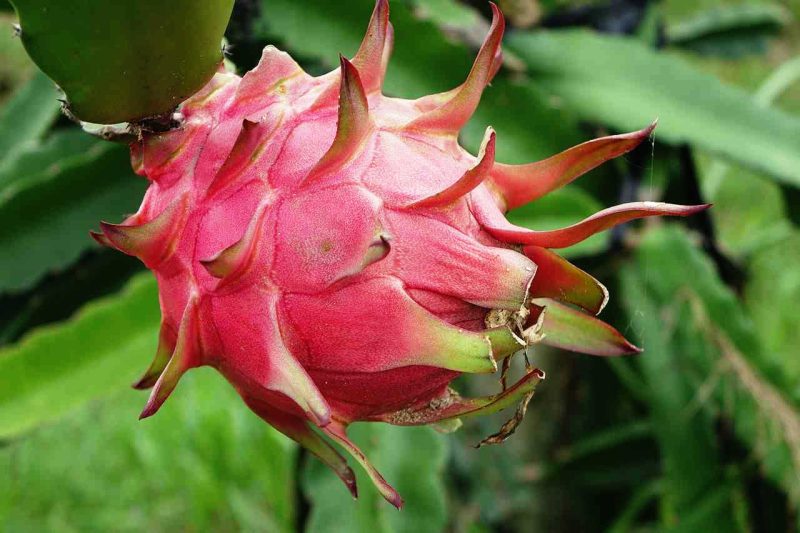
Dragon fruit, also known as pitaya, is a vibrant fruit that belongs to the cactus family, scientifically recognized as Hylocereus spp. Though often associated with tropical environments, certain species of dragon fruit thrive in arid regions and can be found in desert-like conditions. This exotic fruit is not only visually striking—with its bright pink or yellow outer skin and green-tipped scales—but it also brings a refreshing taste and numerous health benefits to the table.
Dragon fruit is known for its high antioxidant content, particularly vitamin C, which supports the immune system and promotes healthy skin. The flesh of the fruit is typically speckled with small, edible black seeds, which provide fiber and healthy fats. The taste is mild yet subtly sweet, often compared to a blend of kiwi and pear, making it a versatile option for both savory and sweet dishes. Dragon fruit can be enjoyed on its own, in smoothies, or as a colorful addition to fruit salads, but its appealing visual presentation makes it a sought-after garnish for cocktails and desserts.
Cultivating dragon fruit is relatively low-maintenance, as the plants are highly drought-tolerant and can flourish in sandy or rocky soils. This adaptability makes them an excellent choice for arid gardens, where they can contribute to sustainable agriculture practices. Additionally, dragon fruit plants are known for their beautiful nocturnal flowers, which bloom for just one night, attracting pollinators such as moths. The cultivation of dragon fruit not only provides delicious fruits but also supports biodiversity within desert ecosystems.
Peruvian Apple Cactus (Cereus peruvianus)
The Peruvian apple cactus, a striking columnar cactus native to South America, is notable for its unique structure and edible fruit. Standing tall with its upright growth and bright green ribs, this cactus can reach impressive heights and serves as an eye-catching feature in desert gardens. It is well adapted to the arid environment, showcasing its thirst for survival through its ability to thrive with minimal water.
The fruit of the Peruvian apple cactus, known as “tuna” or “pitaya,” has a vibrant red or purple exterior, housing juicy, sweet flesh within that is dotted with small seeds. This fruit can be eaten raw, making it a refreshing snack in the hot desert climate. Its sweetness, coupled with a mildly tangy flavor, makes it a fantastic ingredient for fruit salads, smoothies, and desserts. Additionally, the fruit is rich in essential nutrients, including vitamin C, fiber, and antioxidants, providing numerous health benefits.
Beyond its edible fruit, the Peruvian apple cactus has cultural significance. In many regions of South America, the fruit has been historically valued not only as a food source but also in traditional medicine. It is believed to possess anti-inflammatory and antioxidant properties, which contribute to overall health. The cactus’s popularity is spreading beyond its native regions as people become more aware of its nutritional value and unique flavor, making it a promising candidate for cultivation in desert farming initiatives.
Queen of the Night Cactus (Peniocereus greggii)
The Queen of the Night cactus, known scientifically as Peniocereus greggii, is a strikingly beautiful night-blooming cactus native to the deserts of the Southwestern United States and Mexico. While it may easily be identified by its long, slender columns and magnificent, large flowers that bloom only under the moonlight, its culinary uses are a delightful surprise to those unfamiliar with its potential.
The flowers of the Queen of the Night are ephemeral, blooming for just one night and emitting a sweet fragrance that attracts nocturnal pollinators such as bats and moths. However, the real treasure lies in the cactus’s fruit, known as “pitaya” or “cactus fruit.” This fruit appears after the flowering period, bearing a bright red or yellow exterior with soft, spined shells. When harvested, the pulp is sweet, juicy, and can be enjoyed raw or made into jellies, sauces, and desserts, recommended for adding a burst of flavor to fruit salads and smoothies.
Beyond its delightful taste, the Queen of the Night cactus has significant nutritional value. The fruit is rich in vitamin C, fiber, and antioxidants, promoting digestive health and boosting immunity. Additionally, Indigenous cultures have historically used various parts of the cactus for medicinal purposes, including treating wounds and digestive issues. The cultivation of Queen of the Night cactus becomes even more appealing considering its low water requirements, making it an excellent candidate for xeriscaping and sustainable gardening practices. By incorporating this stunning cactus into gardens, we gain not only a striking ornamental plant but also a valuable food source and an ecological ally.
Cholla Cactus (Cylindropuntia spp.)
Cholla cacti, members of the Cylindropuntia genus, are recognized for their distinctive cylindrical segments and spines, which can present a challenge for the unwary. However, they are also beloved for their culinary potential and resilience in some of the most arid regions of North America. With species like the Teddy Bear Cholla and the Staghorn Cholla, these plants offer unique edibility and versatile uses.
The young pads, known as “nopales,” are the most sought-after edible parts of the cholla cactus. Harvesting these pads requires caution due to their spines, which can easily catch onto skin, but when handled correctly, nopales can be cleaned and prepared for numerous dishes. These pads are often grilled, sautéed, or incorporated into salads and soups, bringing a tangy, slightly tart flavor that adds depth to a variety of recipes. Besides being delicious, nopales are loaded with vitamins A and C, calcium, and fiber, making them a nutritious addition to any meal.
Cholla flowers also play a role in desert cuisine. The bright blooms of certain cholla species can be collected and eaten raw or cooked, offering a sweet flavor reminiscent of other edible wildflowers. Furthermore, when it comes to the fruiting period, cholla produces small, spiny fruits known as “cholla buds,” which can also be harvested and used in recipes or enjoyed raw. The buds are particularly nutritious, containing valuable antioxidants and vitamins.
Ecologically, cholla cacti support desert ecosystems by providing shelter and food for various wildlife, including birds and mammals. Their ability to thrive in nutrient-poor soil conditions and exceptional drought tolerance makes them a prime candidate for sustainable desert gardening. By embracing cholla cacti, we not only gain access to a unique and health-packed food source but also enhance biodiversity and resilience in arid landscapes.
Saguaro Cactus (Carnegiea gigantea)
The saguaro cactus is synonymous with the American Southwest, particularly the Sonoran Desert, where it stands as a towering symbol of resilience and beauty. Known for its iconic silhouette, the saguaro can grow to be over 40 feet tall and live for more than 150 years. While its grandeur is often celebrated in art and culture, the saguaro also presents unique opportunities for culinary exploration.
The fruit of the saguaro cactus is a vibrant red or purple berry that typically ripens in late spring or early summer. Rich in nutrients, these fruits are sweet and juicy, with a flavor profile that combines elements of strawberries and kiwi. Harvesting requires skill, as the fruit grows atop tall arms of the cactus. Local Indigenous communities have harvested saguaro fruit for centuries, traditionally collecting it during harvest festivals and using it to make a variety of recipes, including jams, syrups, and even fermented drinks.
In addition to its fruits, the flowers of the saguaro cactus are also edible. These creamy white blossoms bloom at night and attract pollinators, notably bats and bees. While the flowers are less commonly harvested, they can be used to make teas or added to salads for a touch of sweetness and a decorative flourish.
Saguaro cactus contributes remarkably to its ecosystem, as well. The flowers provide critical nectar for pollinators, while the fruits serve as a food source for birds, mammals, and desert-dwelling insects. The cactus itself offers shelter from the desert sun, helping to maintain microhabitats for numerous species. Beyond their functional roles, saguaros are culturally significant; they represent life and endurance in harsh environments, underscoring the importance of these majestic plants in both culinary and ecological contexts.
Hedgehog Cactus (Echinocereus spp.)
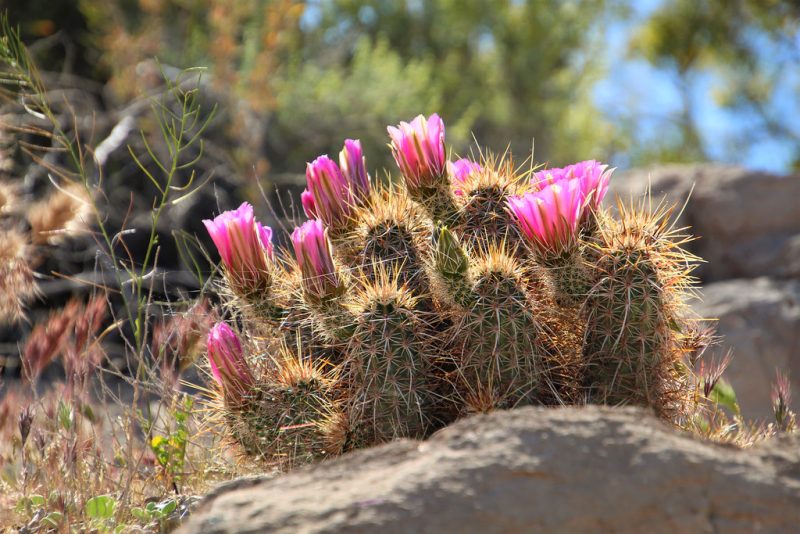
Hedgehog cacti, belonging to the Echinocereus genus, are named for their sculptural appearance, which is often covered in spines that resemble the quills of a hedgehog. Wildly colorful and diverse, these cacti are primarily found in the southwestern regions of the United States and Mexico. Beyond their charming aesthetics, hedgehog cacti offer an assortment of edible parts that are embraced in various culinary traditions.
The fruits of the hedgehog cactus, commonly referred to as “cactus fruit” or “cacti berries,” are typically egg-shaped and can range in color from bright red and pink to deep purple. These small, succulent fruits are sweet and tangy, making them a delicious addition to deserts, fruit salads, and beverages. They can be eaten raw or made into jams and jellies, often praised for their vibrant color and distinct flavor. Notably, the fruit is rich in vitamins, particularly vitamin C, and provides essential antioxidants that can contribute to overall health.
The pads of certain hedgehog cacti can also be consumed, often prepared in similar ways as nopales from cholla cacti. When harvested, they must be cleaned carefully to remove spines, resulting in a tender and nutritious vegetable that can be grilled, sautéed, or added to salads. The mild taste of hedgehog pads allows them to absorb other flavors, making them versatile in a variety of dishes.
Additionally, hedgehog cacti have adapted well to their environments, thriving in rocky, scarce soils with minimal water, which makes them an ideal choice for low-maintenance gardens. Their intricate flowers also attract pollinators, providing essential support for local ecology. As a result, hedgehog cacti are a prime example of edible plants that enhance biodiversity while enriching our diets.
Blue Myrtle Cactus (Myrtillocactus geometrizans)

The blue myrtle cactus, scientifically named Myrtillocactus geometrizans, is native to the warmer regions of Mexico and can bear striking resemblance to a blue-tinged succulent. Often used as an ornamental plant, its long, upright growth habit and distinctive blue-green skin make it a striking addition to any garden. However, what makes this cactus particularly fascinating is its culinary potential, which has been utilized for generations.
The fruit of the blue myrtle cactus resembles a small blueberry when ripe, typically turning a deep purple or blue color. These berries can be eaten raw and are known for their sweet flavor, reminiscent of traditional berries but with a unique twist. They are often used to make jams, jellies, or syrups, lending their vibrant hue and rich, sweet taste to a variety of deliciously crafted culinary treats. Furthermore, the high antioxidant content in these fruits makes them a nutritious option, contributing to heart health and overall wellness.
Beyond the fruits, the pads of the blue myrtle cactus can also be used in cooking. While they are not as widely known as some other cactus pads, they are still edible and can be prepared similarly to nopales, providing a delightful texture and taste.
Moon Cactus (Gymnocalycium mihanovichii)
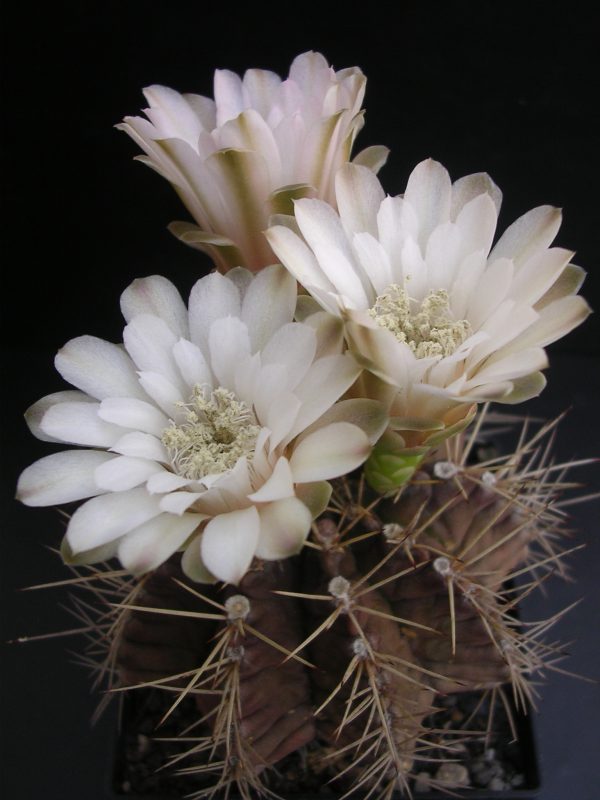
The moon cactus, scientifically recognized as Gymnocalycium mihanovichii, is a fascinating and colorful cactus. Known for its vibrant tops, which can be red, pink, or yellow, the moon cactus is often grafted onto a green base cactus to enhance its ornamental appeal. While often appreciated for its unusual appearance, particularly in succulent collections and decorative gardening, the moon cactus also has interesting culinary potential, albeit indirectly.
Though the green base of the moon cactus is edible, the brightly colored top, which is a mutant form lacking chlorophyll, is primarily grown for ornamental purposes and isn’t typically consumed. However, the green understock, which supports the vibrant top, can be part of a culinary adventure for those in search of edible desert plants. This portion of the plant can be prepared similarly to other edible cacti, often used as a refreshing addition in salads or as a garnish in various dishes. The flavor is mild, allowing it to absorb other ingredients, making it a subtle but nutritious choice for enhancing meals.
Although it lacks significant historical culinary use compared to some other cacti, the rising interest in foraging and sustainable gardening has sparked curiosity about all parts of the moon cactus. The ecological aspect of growing edible cactus underscores the importance of incorporating a variety of plants in gardens that both contribute to biodiversity and offer nourishment. Thus, while the moon cactus might not be a primary food source, it symbolizes the intersection of beauty and utility in desert flora.
Beehive Cactus (Coryphantha spp.)
The beehive cactus, belonging to the Coryphantha genus, derives its name from its unique shape that resembles the honeycombed structure of a beehive. Predominantly found in the arid landscapes of Mexico and the southwestern United States, beehive cacti showcase a distinct appearance composed of rounded, ribbed bodies covered in a dense coat of spines. Beyond their visual appeal lies a delightful secret: the cactus produces edible fruit that can benefit those looking for sustenance in the desert.
During its flowering period, the beehive cactus produces small, round fruits that resemble tiny apples or berries. These fruits, often red or yellow when ripe, are not just visually appealing but are sweet and juicy, offering a refreshing taste in the warm desert climate. They are typically harvested in late spring or summer and can be eaten raw or used in cooking. The fruit is often transformed into jams, jellies, or syrups, creating a unique connection between the robust flavors of the desert environment and the culinary arts.
Furthermore, the pads of the beehive cactus, when young and tender, can also be used in cooking, similar to nopales from other cacti. They can be chopped and added to salads, used as a garnish, or cooked in various dishes. High in fiber and low in calories, beehive cactus pads not only add flavor but also contribute beneficial nutrients to the diet.
Ecologically speaking, beehive cacti serve as important habitats for wildlife, providing shelter and food sources for various desert creatures. Their clever adaptations to thrive in arid environments highlight the remarkable strategies plants have developed to survive, thrive, and sustain life in some of nature’s harshest conditions.
Escontria Cactus (Escontria chiotilla)
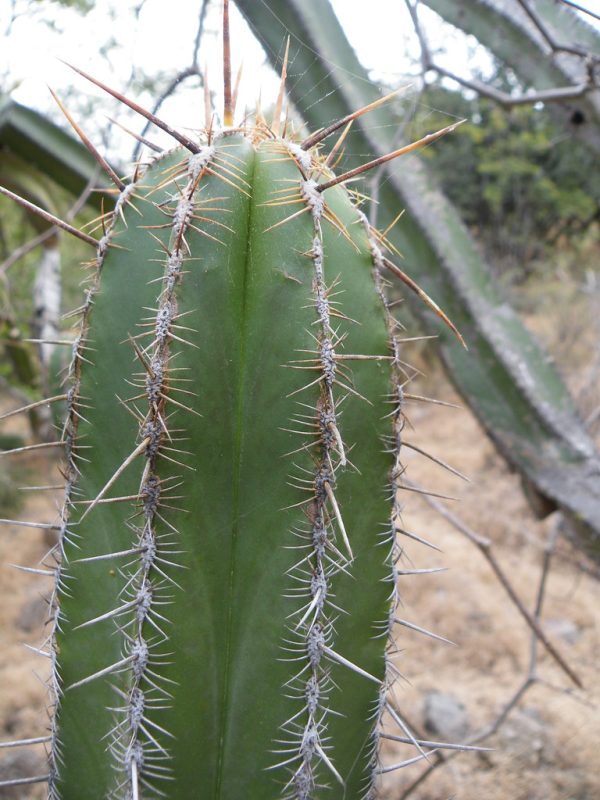
Escontria cactus, an intriguing member of the Cactaceae family, is primarily found in the rich and diverse habitats of Mexico. Often referred to as “the edible cactus” or “the chiotilla cactus,” it is renowned for both its ornamental qualities and culinary potential. With its tall, upright growth and thick, succulent pads, this cactus storyline expands significantly in the context of edible desert plants.
The primary edible part of the escontria cactus is its pads, known for their thick, fleshy textures, making them versatile in cooking. It is often compared to other edible cacti like nopales and can be prepared through various methods, such as grilling, boiling, or sautéing. When cooked, escontria pads offer a unique flavor and slightly chewy texture, often described as mild and vegetal, making them an excellent addition to salads, tacos, or stir-fries. Their nutritional value is considerable, as they are low in calories while providing essential vitamins, minerals, and fiber.
One of the most exciting aspects of the escontria cactus is its flowers and fruit. The vibrant blossoms bloom in the spring and can be collected for culinary decoration or used to enhance dishes with a splash of color. After flowering, the cactus produces inviting fruit that is typically oval-shaped, showcasing a sweet pulp that can be enjoyed fresh or made into delicious jams and beverages. Rich in antioxidants and nutrients, these fruits are a testament to the nutritional bounty that desert plants can offer.
Barbados Gooseberry Cactus (Pereskia aculeata)
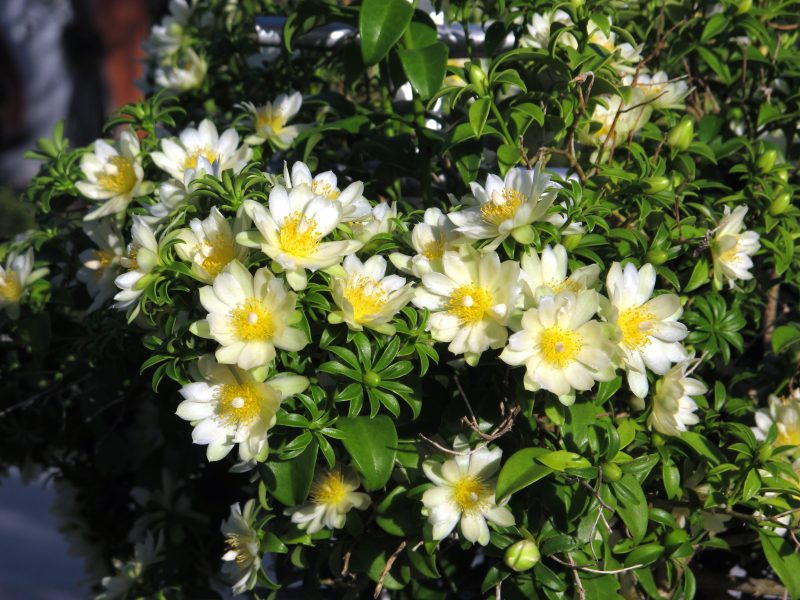
The Barbados gooseberry cactus, scientifically known as Pereskia aculeata, is a unique member of the cactus family that harkens back to a time before the classic cactus morphology evolved. Unlike many of its spiny relatives, the Barbados gooseberry resembles a shrub with green, leafy stems and produces delectable fruits that are both nutritious and versatile in the culinary world.
Native to tropical and subtropical regions of Central and South America, this cactus has the distinction of having edible leaves in addition to its fruit, making it truly multifunctional. The leaves can be consumed raw in salads or cooked like spinach, adding a mild, slightly tangy flavor to a variety of dishes. Packed with essential vitamins and minerals, the leaves are an excellent source of vitamin C, potassium, and antioxidants, promoting overall health.
The fruit of the Barbados gooseberry cactus is small, round, and typically turns a bright yellow or orange as it ripens. Known for its sweet and tart flavor, the fruit can be enjoyed fresh or utilized to make jams, jellies, and beverages. These fruits are not only delicious but also provide valuable dietary fiber and vitamin C, making them a fantastic addition to any diet rooted in natural nourishment.
Cultivating Barbados gooseberry cactus can be an effective way to enhance food security in arid regions. Its hardy structure allows it to thrive in poor soils while requiring minimal water, which perfectly aligns with sustainable gardening practices. Additionally, its adaptability to various climates encourages gardeners to experiment with growing this edible cactus, reaping both its culinary benefits and its contribution to biodiversity.
More Edible Desert Plant Ideas
Exploring the world of edible desert plants opens up a treasure trove of culinary opportunities, and the list extends far beyond the previously mentioned cacti. Here are a few more exciting desert plants that offer unique flavors and health benefits:
Desert Willow (Chilopsis linearis): A beautiful tree commonly found in the Southwestern U.S., the desert willow produces fragrant flowers that can be used to make herbal teas. The young seed pods can also be harvested and prepared in various ways, adding a colorful presentation and subtle sweetness to salads and desserts.
Prickly Pear (Opuntia spp.): Perhaps one of the most well-known edible desert plants, prickly pear cacti bear vibrant fruits called “tunas” and pads called “nopales.” The fruit can be eaten raw, made into drinks, or turned into jellies and syrups, while the pads are nutritious and versatile. They can be grilled, sautéed, or added to stir-fries, making them a staple in many traditional dishes.
Desert Fig (Ficus petiolaris): This lesser-known fig species thrives in rocky desert environments and bears small, sweet fruits. The figs are often rich in vitamins and can be eaten fresh or dried, offering a burst of flavor reminiscent of traditional figs. They can also be turned into jams or used in baking for added sweetness.
Wild Mesquite (Prosopis spp.): This tree is often overlooked in desert plant discussions but is a vital source of nutrition. The pods can be harvested, dried, and ground into a flour that is high in protein and can be used in various recipes, from breads to pancakes. The sweet flavor of mesquite adds a distinctive taste to baked goods, enhancing both nutritional value and flavor.
Chicory (Cichorium intybus): In the arid regions, chicory is often found growing wild. Both the leaves and roots are edible and nutritious. The young leaves can be added fresh to salads, while the roasted roots can be brewed to create a caffeine-free coffee substitute. The roots have a slightly nutty, earthy flavor that makes them a delightful addition to various recipes.
Salsify (Tragopogon porrifolius): Also known as “oyster plant,” salsify is found in arid environments and produces a long, edible root with a flavor reminiscent of oysters. The roots can be harvested, boiled, or roasted, and they are often added to soups or used as a vegetable side dish, providing an interesting taste twist to meals.


